Seat belts
Seat belts
Adjusting your driving position
Always wear your seat belt when travelling in your vehicle. You must also comply with
the legislation of the particular country you are in.
Before starting, first adjust your driving position, then ask all occupants to adjust
their seat belts to ensure optimum protection.
Tip
WARNING
Incorrectly adjusted or twisted seat belts may cause injuries in the event of an accident.
Use one seat belt per person, whether child or adult.
Even pregnant women should wear a seat belt. In this case, ensure that the lap belt
is not exerting too much pressure on the abdomen, but do not allow any slack.
- Sit well back in your seat (having removed your coat or jacket, etc.). This is essential to ensure that your back is positioned correctly;
- adjust the distance between the seat and the pedals. Your seat should be as far back as possible while still allowing you to fully depress the pedals. The seatback should be adjusted so that your arms are slightly bent when you hold the steering wheel;
- adjust the position of your headrest. For maximum safety, your head must be as close as possible to the headrest;
- adjust the height of the seat. This adjustment allows you to select the seat position which offers you the best possible view;
- adjust the position of the steering wheel.
Adjusting the seat belts
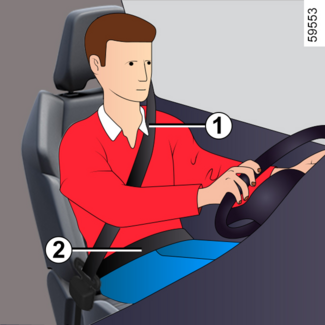
For correct adjustment and positioning of the seat belts at all seats:
- adjust the seats (seat position and seatback angle, if available);
- sit with your back firmly against the seatback;
- move the shoulder strap 1 as close as possible to the base of the neck without it actually resting against it (if necessary, adjust the height of the seat belt if available) and make sure that the shoulder strap 1 is in contact with the shoulder;
- position the lap belt 2 so that it lies flat on the thighs and against the pelvis.
The seat belt must be worn as close to the body as possible. e.g. avoid wearing heavy
clothing, keeping bulky objects under the belts, etc.
Locking, unlocking
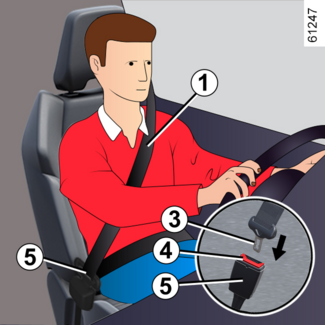
Locking
Unwind the belt slowly and smoothly and ensure that the buckle 3 locks into the catch 5 (check that it is locked by pulling on the buckle 3).
If the belt jams, allow it to return slightly before attempting to unwind it again.
If your seat belt is completely jammed, pull slowly, but firmly so that just over
3 cm unwinds. Allow it to return slightly before attempting to unwind it again.
If there is still a problem, contact an approved dealer.
Unlocking
Press the button 4 and the seat belt will be rewound by the inertia reel. Guide the belt.
Driver’s seat belt reminder and, depending on the vehicle, front passengers' seat belt reminder
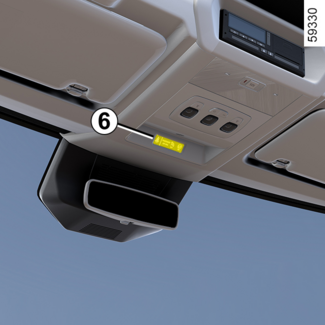
Instrument panel A
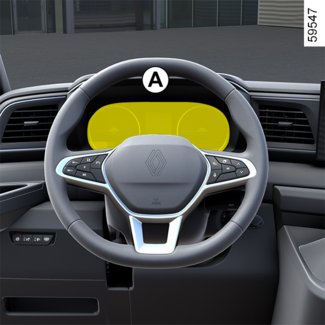
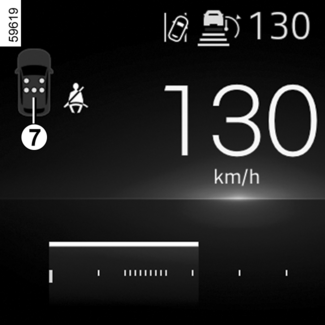
Driver’s seat belt reminder and, depending on the vehicle, front passengers' seat belt reminder
With the doors closed, the graphic 7 is displayed on the instrument panel A for approximately 60 seconds when the vehicle ignition is switched on. This informs
the driver of the fastening status of each of the front seat belts every time:
- the doors are opened during driving (vehicle speed above zero);
- a front seat belt is fastened/unfastened.
Understanding the graphic 7:
- seat belt fastened;
- seat occupied and seat belt unfastened;
- seat not occupied.
With the doors closed, the  warning light appears on the central display 6 when the vehicle ignition is switched on if the driver's and/or front passenger's
seat belt(s) (if this seat is occupied) are not fastened.
warning light appears on the central display 6 when the vehicle ignition is switched on if the driver's and/or front passenger's
seat belt(s) (if this seat is occupied) are not fastened.
When the vehicle speed is less than approximately 12 mph (20 km/h), the  warning light appears on the central display 6 if a front seat is occupied and the seat belt is not fastened. It is accompanied
by the graphic 7 which appears for approximately 60 seconds each time one of the front seat belts
is fastened or unfastened.
warning light appears on the central display 6 if a front seat is occupied and the seat belt is not fastened. It is accompanied
by the graphic 7 which appears for approximately 60 seconds each time one of the front seat belts
is fastened or unfastened.
When the vehicle speed reaches or exceeds 12 mph (20 km/h), if one of the front seat
belts is unfastened or becomes unfastened during the journey:
- the
warning light flashes on the central display 6;
and
- a beep sounds for around 120 seconds;
and
- the graphic 7 is displayed for approximately 180 seconds and the
symbol for the seat concerned is displayed.
Always make sure that the front passengers are properly fastened in and that the number
of seat belts indicated as fastened corresponds to the number of front seats occupied.
Note: an object placed on the front passenger seat may trigger warnings in some cases.
Rear seat belt reminder warning light (depending on the vehicle)
With the doors closed, the graphic 7 is displayed on the instrument panel A for approximately 60 seconds when the vehicle ignition is switched on. This informs
the driver of the fastening status of each of the rear seat belts every time:
- the doors are opened during driving (vehicle speed above zero);
- a rear seat belt is fasted or unfastened.
Understanding the graphic 7:
- seat belt fastened;
- seat belt unfastened.
When the vehicle speed is below approximately 12 mph (20 km/h), the graphic 7 appears during approximately 60 seconds every time one of the rear seat belts is
fastened or unfastened.
When the vehicle speed reaches or exceeds 12 mph (20 km/h), if one of the rear seat
belts is unfastened during the journey:
- the
warning light flashes on the central display 6;
and
- a beep sounds for around 30 seconds;
and
- the graphic 7 is displayed for at least 60 seconds and the
symbol for the seat concerned is displayed.
Always make sure that the rear passengers are properly fastened in and that the number
of seat belts indicated corresponds to the number of rear seats occupied.
Instrument panel B
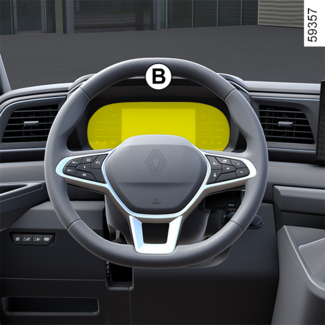
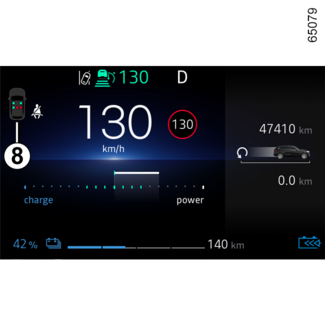
Driver’s seat belt reminder and, depending on the vehicle, front passengers' seat belt reminder
With the doors closed, the graphic 8 is displayed on the instrument panel B for approximately 60 seconds when the vehicle ignition is switched on. This informs
the driver of the fastening status of each of the front seat belts every time:
- the doors are opened during driving (vehicle speed above zero);
- a front seat belt is fastened/unfastened.
Understanding the graphic 8:
- symbol in green: seat belt fastened;
- symbol in red: seat occupied and seat belt not fastened;
- symbol in grey: seat not occupied.
With the doors closed, the  warning light appears on the central display 6 when the vehicle ignition is switched on if the driver's and/or front passenger's
seat belt(s) (if this seat is occupied) are not fastened.
warning light appears on the central display 6 when the vehicle ignition is switched on if the driver's and/or front passenger's
seat belt(s) (if this seat is occupied) are not fastened.
When the vehicle speed is less than approximately 12 mph (20 km/h), the  warning light appears on the central display 6 if a front seat is occupied and the seat belt is not fastened. It is accompanied
by the graphic 8 which appears for approximately 60 seconds each time one of the front seat belts
is fastened or unfastened.
warning light appears on the central display 6 if a front seat is occupied and the seat belt is not fastened. It is accompanied
by the graphic 8 which appears for approximately 60 seconds each time one of the front seat belts
is fastened or unfastened.
When the vehicle speed reaches or exceeds 12 mph (20 km/h), if one of the front seat
belts is unfastened or becomes unfastened during the journey:
- the
warning light flashes on the central display 6;
and
- a beep sound for approximately 120 seconds;
and
- the graphic 8 is displayed for approximately 180 seconds and the symbol for the seat concerned appears in red.
Always make sure that the front passengers are properly fastened in and that the number
of seat belts indicated as fastened corresponds to the number of front seats occupied.
Note: an object placed on one of the front passenger seats may trigger warnings in some
cases.
Rear seat belt reminder warning light (depending on the vehicle)
With the doors closed, the graphic 8 is displayed on the instrument panel for approximately 60 seconds when the vehicle
ignition is switched on. This informs the driver of the fastening status of each of
the rear seat belts every time:
- the doors are opened during driving (vehicle speed above zero);
- a rear seat belt is fasted or unfastened.
Understanding the graphic 8:
- symbol in green: seat belt fastened;
- symbol in red: seat belt unfastened.
When the vehicle speed is below approximately 12 mph (20 km/h), the graphic 10 appears during approximately 60 seconds every time one of the rear seat belts is
fastened or unfastened.
When the vehicle speed reaches or exceeds 12 mph (20 km/h), if one of the rear seat
belts is unfastened during the journey:
- the
warning light flashes on the central display 6;
and
- a beep sounds for around 30 seconds;
and
- the graphic 8 is displayed for at least 60 seconds and the symbol for the seat concerned appears in red.
Always make sure that the rear passengers are properly fastened in and that the number
of seat belts indicated as fastened corresponds to the number of rear seats occupied.
Adjusting the height of the front seat belts
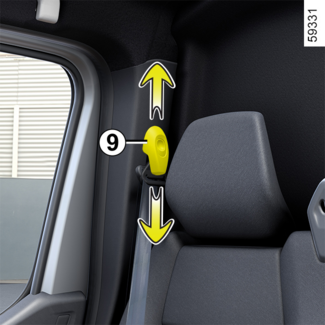
Press the button 9 to adjust the seat belt height, so that the shoulder strap is worn as shown previously.
Press the button 9 and raise or lower the seat belt.
Make sure that the seat belt is locked in position correctly after you have adjusted
it.
Seat with armrest(s)
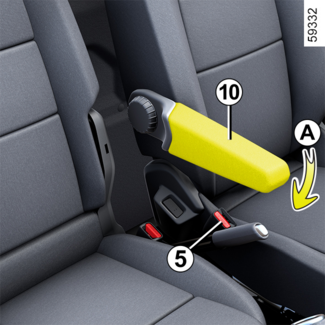
Ensure that the seat belt is passed underneath the armrest 10, check that the buckle 3 is fastened in the catch 5.
Lower the armrest 10 on the door side (movement A).
Unwind the belt slowly and smoothly.
Pass the lap belt under the armrest 10 and the shoulder strap over the armrest 10.
Make sure the buckle locks into the catch (check that it is locked by pulling on the
buckle).
Warning
The following information applies to the vehicle’s front and rear seat belts.
WARNING
- No modification must be made to the originally-fitted restraint system components (seat belts, seats and their mountings). For special operations (e.g. fitting a child seat), please contact an approved dealer.
- Do not use any devices which slacken the belts (e.g. clothes peg, clip, etc.) as a seat belt which is worn too loosely may cause injury in the event of an accident.
- Never wear the shoulder strap under your arm or behind your back.
- Never use the same belt for more than one person and never hold a baby or child on your lap with your seat belt around them.
- The belt should never be twisted.
- Following an accident, have the seat belts checked and replaced if necessary. Always replace your seat belts as soon as they show any signs of wear.
- Make sure that the seat belt buckle is inserted into the appropriate catch.
- Ensure that no objects are placed in the area around the seat belt catch as they could prevent it from being properly secured.
- Make sure the seat belt catch is properly positioned (it should not be hidden away, crushed or flattened by people or objects).